POPULATION
High literacy among women and men in the NCR
Among the regions in the Philippines, the National Capital Region (NCR) achieved the highest literacy rate, reaching 98.9 percent based on the result of the 2020 Census on Population and Housing (2020 CPH). Of the 12.12 million household population aged five years and above in the NCR, 11.99 million were literate, accounting for 98.9 percent of the population. The literacy rate of women at 98.9 percent was slightly higher than that of men at 98.8 percent.
By age group, the highest literacy rate was observed among individuals aged 15 to 64 years (working age or economically active), with 99.9 percent literacy. This rate was consistent for both women and men within this age group. The age group 65 and above also demonstrated a high literacy rate of 99.7 percent, with 99.6 percent for women and 99.8 percent for men. The age group under 15 years old (young dependents) had a literacy rate of 95 percent (95% for women and 94.9% for men). (See Figure 1 and Table 1 for details)

More women than men attain higher levels of education
The 2020 CPH revealed that more women than men attained higher levels of education, including education beyond the secondary level or high school level. Of the 12.12 million household population aged five years and over, 2.43 million women pursued higher levels of education accounting for 20.0 percent of the household population and 39.7 percent of the women's household population. In comparison, men were 2.20 million accounting for 18.1 percent of the household population and 36.6 percent of the men's household population.
Moreover, 34.9 percent of the household population aged five years and over had reached or completed at most college level. Within this group, 18.5 percent were women (11.4% graduate, 7.1% undergraduate) and 16.4 percent were men (9.4% graduate, 7.0% undergraduate). Of the household population, 39.0 percent had reached or completed at most high school or secondary level, while 18.8 percent had reached or completed at most elementary level. Furthermore, 0.6 percent had reached or completed the post-baccalaureate level. (See Figure 2 and Table 2 for details)

Overseas women workers are less than men
In 2020, there were 221 thousand residents in the NCR reported as overseas workers. Among them, women comprised 101 thousand or approximately 45.6 percent, while men made up 120 thousand, accounting for 54.4 percent. (Refer to Table 3)

Functional difficulty is higher in women than in men

Out of the 12.12 million household population aged five years and over, approximately 959 thousand persons had at least one domain or category of functional difficulty, representing about eight in every 100 population (7.9%). Among these, women account for 4.6 percent while men comprise 3.3 percent, resulting in a sex ratio of 73 men for every 100 women with at least one domain of functional difficulty.
Among the 959 thousand persons with at least one domain or category of functional difficulty, 7.0 percent were mild (4.1% in women and 2.9% in men), 0.7 percent were moderate (0.4% in women and 0.3% in men), and 0.3 percent were severe (0.1% in women and 0.1% in men). Notably, the age group 60 to 64 years old exhibited the highest number of individuals with at least one functional difficulty domain, totaling 109 thousand or 0.9 percent of the household population aged five years and above. This breakdown included 0.5 percent women and 0.4 percent men. Conversely, the age groups 5 to 9 recorded the lowest number of individuals with functional difficulty. (Figure 3 and Table 4)
Most women and men in the region are never married
Of the region’s 10.89 million household population aged ten years and over in 2020, 4.19 million individuals (38.5%) were single or never married by marital status. This group comprised 1.99 million women (18.3%) and 2.20 million men (20.2%). At the same time, there were 3.79 million (34.8%) married persons, comprising 1.90 million women (17.4%) and 1.89 million men (17.3%).
The remaining household population was in common-law/live-in with 2.19 million (10.0% in women and 10.1% in men), divorced/separated with 283 thousand (1.7% in women and 0.9% in men), and widowed with 441 thousand (3.2% in women and 0.9% in men). (Figure 4 and Table 5)
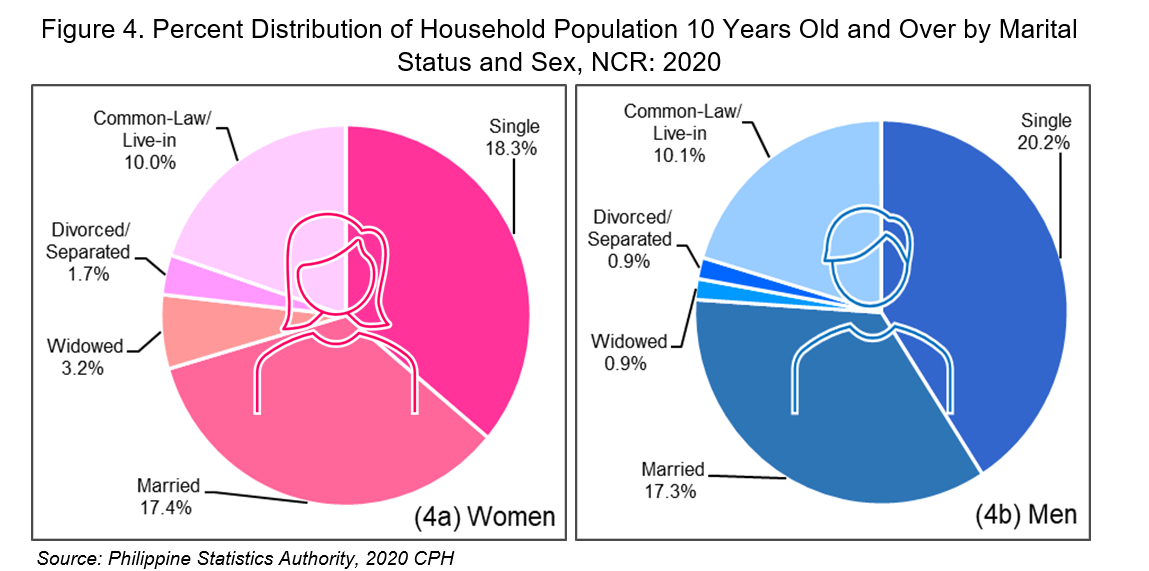
One in five women marry at the age of 20
Out of the 2.38 million ever-married women aged 15 to 49 years old in 2020, one of every five women entered their first marriage at the age of 20, marking it as the most common age for first marriages in the region with 295 thousand women or 12.4 percent. Among the ever-married women, 21.9 percent were wedded at 19 years and below or during their adolescent years, while 65.2 percent married at age 20 and above.
Moreover, more than half of the ever-married women aged 15-49 first married at the age of 24 and below, or during their school-age years, accounting for 1.40 million or 58.8 percent. Meanwhile, 12.9 percent of ever-married women did not provide information on their age at first marriage. (Figure 5 and Table 6)
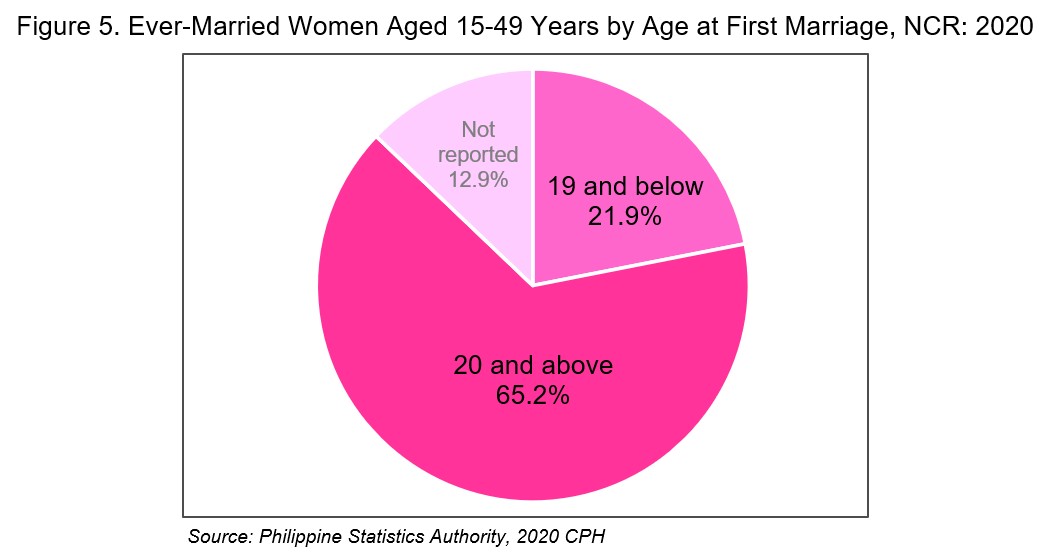
VITAL STATISTICS
Less women than men are born in the NCR
In 2022, less women (77,010 or 48.1%) than men (83,122 or 51.9%) were born in the region, resulting in a sex ratio at birth of 108 men per 100 women. Among the total live births by usual residence of mothers in the region, Quezon City recorded the highest number of birth occurrences for both women and men, accounting for 10.2% and 10.9%, respectively. This was followed by the City of Manila (6.9% for women and 7.6% for men) and the City of Caloocan (6.4% for women and 6.9% for men). Conversely, Pateros recorded the lowest number of total live births, with 692 births, comprising 341 women (0.2%) and 351 men (0.2%). (Figure 6 and Table 7)
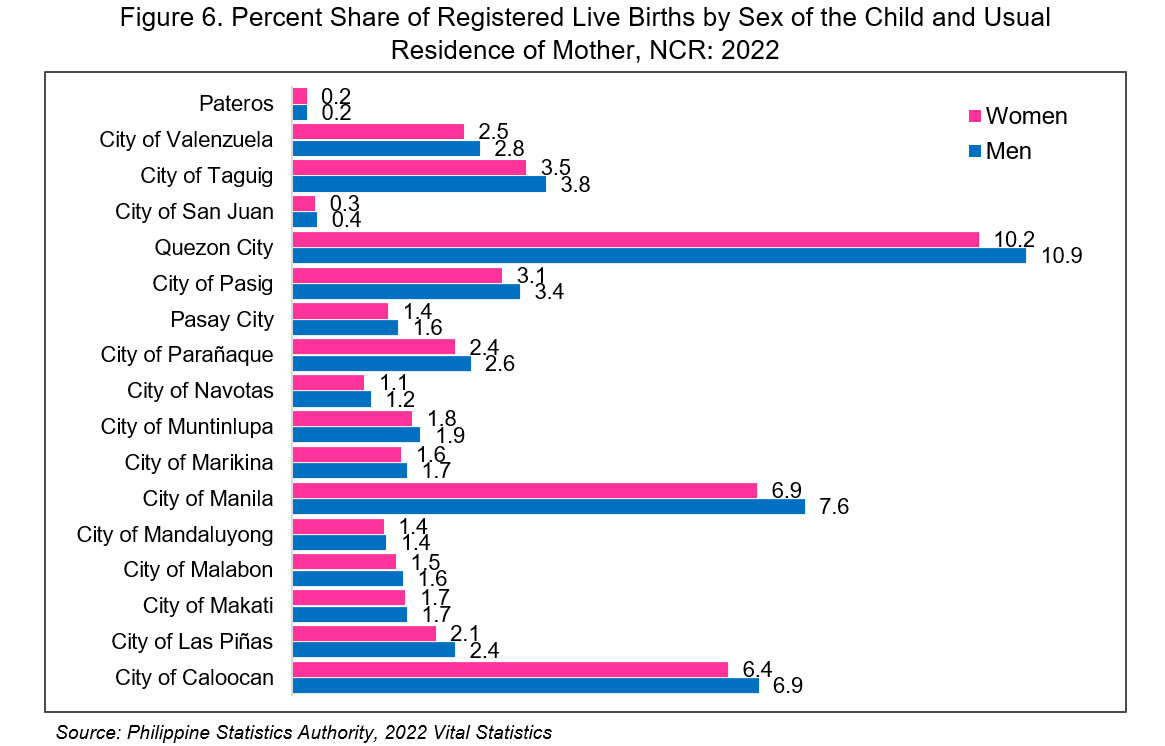
About three in ten newborn babies are born to mothers aged 25-29 years old
Out of the total 160 thousand registered births in the region in 2022, approximately three in ten births were delivered by mothers aged 25 to 29 years old, accounting for 29.0% of the total. This was followed by the age groups 30 to 34 and 20 to 24, with 24.5 percent and 21.7 percent, respectively. The age group of 25 to 29 had the highest number of births in the region in 2021.
There was a notable decline of 10.2 percent in births from adolescent women aged 19 and below, dropping from 28,894 births or 18.0 percent of the total in 2021 to 12,542 births or 7.8 percent in 2022. Furthermore, the City of Muntinlupa had the highest number of births to adolescent women aged 19 and below, followed by the City of San Juan and the City of Manila from 2021 to 2022. (Figure 7 and Table 8)

Highest recorded marriages within the age group 25 to 29
Out of the 54,629 registered marriages in the region in 2022, the highest number of registered marriages for both sexes were within the age group of 25 to 29, comprised of 20,540 or 37.6 percent in women and 16,928 or 31.0 percent in men. It was followed by the age group of 30 to 34 with 15,119 or 27.7 percent in women and 16,542 or 30.3 percent in men. Meanwhile, there were few recorded marriages in teenagers aged 15 to 19, with 0.9 percent in women and 0.2 percent in men, and no recorded marriages involving teenage women and men under 15 years old. (Figure 8 and Table 9)
The highest number of marriages in the region occurred in Quezon City with 18,518 marriages, followed by the City of Manila with 8,935 marriages, and the City of Caloocan with 5,609 recorded marriages. (Table 9)
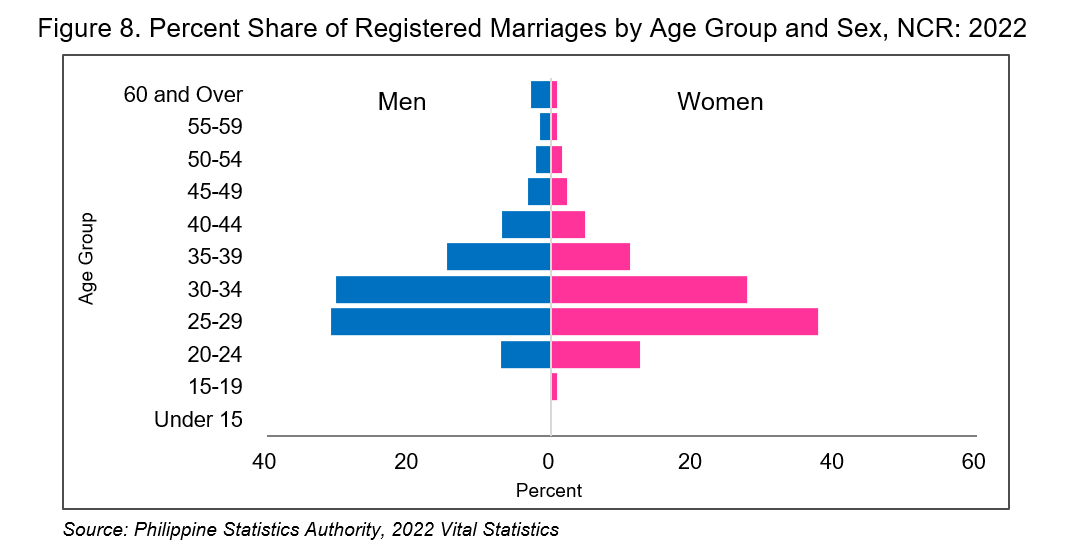
Lower number of deaths in women than men
Out of the total 78,917 registered deaths whose usual residence of the deceased is in the NCR, men accounted for 43,940, representing 55.7%, while women accounted for 34,977, accounting for 44.3%. This resulted in a sex ratio of 126, indicating that there were 126 deaths in men for every 100 deaths in women.
The highest recorded deaths among women and men in the NCR were in Quezon City (9.7% for women and 12.1% for men), followed by the City of Manila (6.8% for women and 8.5% for men), and the City of Caloocan (5.3% for women and 6.9% for men). On the other hand, the lowest recorded deaths were in Pateros (0.2% in women and 0.3% in men). Followed by the City of San Juan with 0.5 percent in both sexes. (Figure 9 and Table 10)
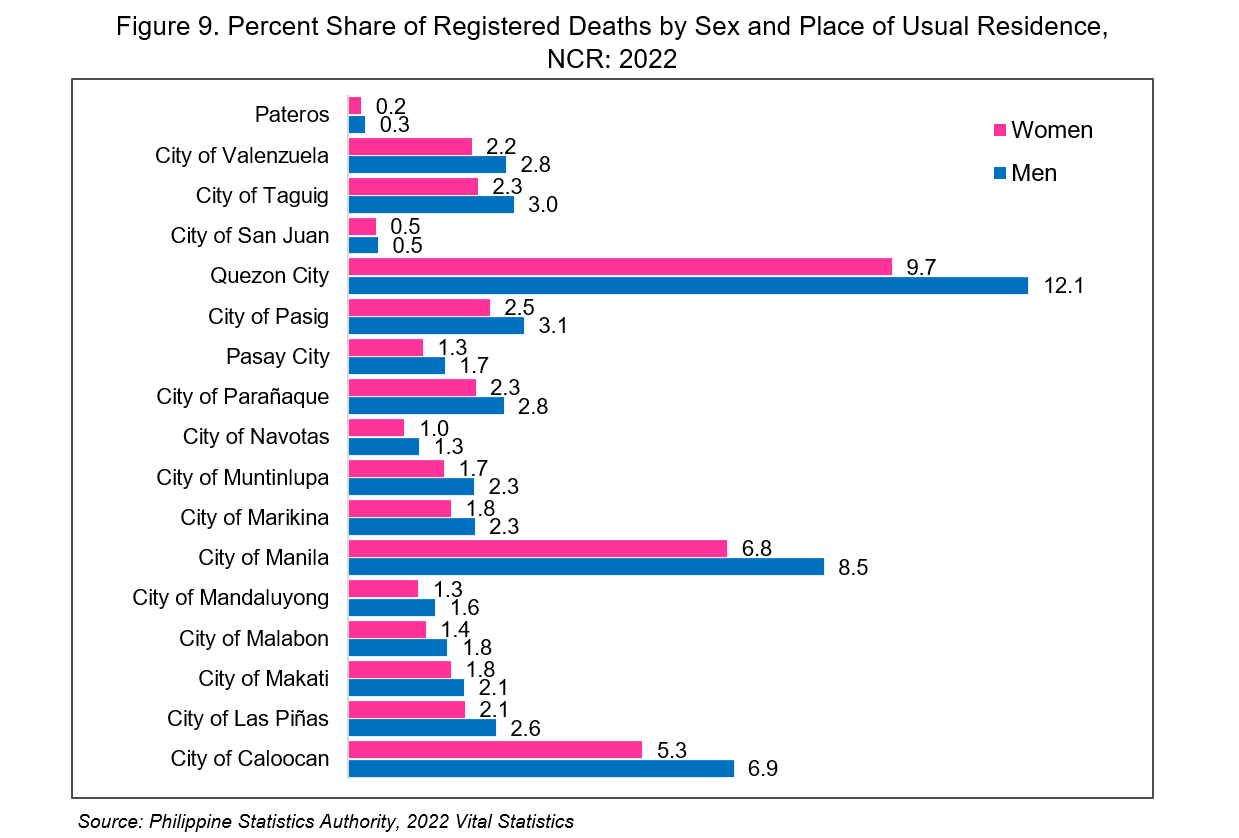
Leading causes of death in women and men
In 2022, Ischaemic heart diseases were the biggest contributor to the total deaths in the region with 22,325 deaths accounting for 28.3 percent. This was followed by deaths due to neoplasms with 9,604 deaths (12.2%), cerebrovascular diseases with 6,713 deaths (8.5%), COVID-19 with 4,526 deaths (5.7%) encompassing virus-identified and not identified cases, and diabetes mellitus with 4,525 deaths (5.7%). (Figure 10 and Table 11)
These leading causes of death exhibited a consistent trend across both sexes with slight variations in ranking. Among women, Diabetes mellitus surpassed Pneumonia and COVID-19. Conversely, among men, diseases of the liver took precedence, overshadowing the remainder of diseases of the genitourinary system. (Table 11)
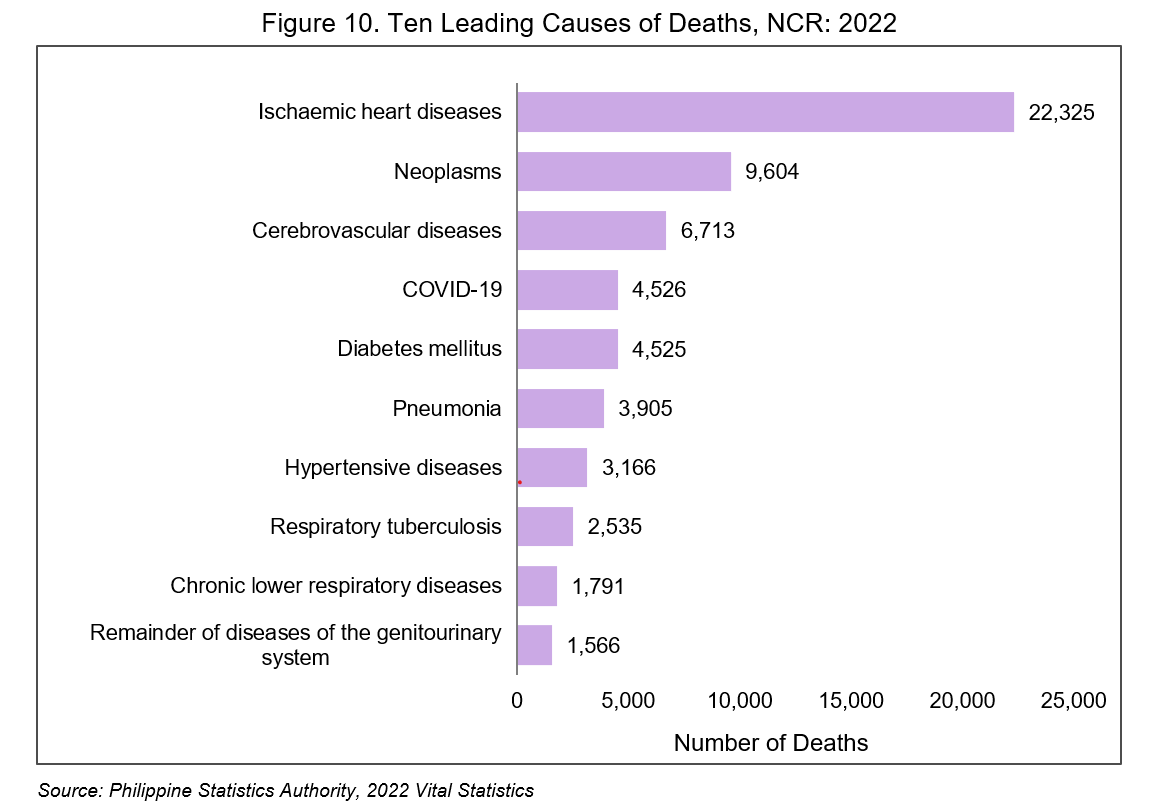
PACIANO B. DIZON
Regional Director
